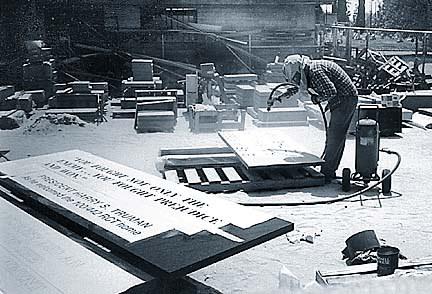


L.A. ‘Go for Broke’
monument is ready
Sen. Inouye will keynote a
By Gregg K. Kakesako
ceremony honoring WWII
Japanese-American vets
Star-BulletinMore than 100 Japanese-American World War II veterans from Hawaii plan to attend the June 5 unveiling of the "Go for Broke Monument" -- the first one on the mainland recognizing their war-time heroics -- in Los Angeles.
Its organizers had hoped to have Gen. Eric Shinseki, the highest-ranking Asian-American military officer, keynote the ceremonies and a subsequent banquet. But the crisis in Kosovo forced a change in plans for Shinseki, who is supposed to be sworn in as the Army's chief of staff June 21.
Instead, U.S. Sen. Daniel K. Inouye, who lost his right arm and earned the Distinguished Service Cross while fighting the Germans with the 442nd Regimental Combat Team, will deliver the main address.
He will be joined at the podium at both the unveiling ceremony and celebration luncheon by Secretary of the Army Louis Caldera.
Ron Oba, 76 and a member of the 442nd RCT, said until now he has only seen drawings of the proposed monument and photos of it being constructed.
"It looks nice," said Oba, a member of F Company, 2nd Battalion, noting that construction had to be delayed for six months while the city rerouted a 20-inch water main line that lay under the monument.
The $2.5 million black granite monument measures 40 feet in diameter and at its tallest point is 9 feet. A granite cut out shaped like the unit's shoulder patch rests in front of the memorial next to an eternal flame.
Where: Los Angeles Civic Center THE GO FOR BROKE MONUMENT
When: June 5
Honors: 15,987 Japanese-American soldiers who fought in World War II
Height: 9 feet
Diameter: 40 feet
The memorial is part of a city park near the civic center in downtown Los Angeles located near the Japanese American National Museum and the Geffen Contemporary Museum.
Roger Yanagita, a Los Angeles architect whose design beat 137 entries from around the world, said his concept for the monument "came from reading and hearing about the different battles" fought on the European continent between 1943-45 by soldiers of the 100th Battalion and the 442nd RCT.
"In a lot of their battles, their objective was to take a hill occupied by the enemy," said Yanagita, whose parents were sent to an internment camp in Idaho following the bombing of Pearl Harbor in 1941. "The enemy was always on top of the hill and the 442nd and the 100th were on the bottom.
"There was no secret on how to take the objective. It was just to charge up the hill and take it ... shouting "Go for Broke,' and that was the reason there were so many casualties."
These second-generation Japanese Americans, or nisei, won 18,142 individual decorations for valor making the 100th Battalion and the 442nd Regimental Combat Team "the most decorated unit for its size and length of service in the history of the United States."
The circular black granite monument rises to a peak on one side, representing the mountains of Italy and France, where they fought. On the other side, it tapers to a grade level.
The names of 15,987 nisei soldiers who served in Europe and the Pacific are engraved on the wall. A star designates those killed in action. The list also includes the names of 37 Japanese American women who served.
A cluster of vertical donor pillars, which symbolizes the trees found in the battlefields of the Vosges Forest in France where the 100th and the 442nd RCT suffered their worst casualties, flanks the monument.
Oba, who will represent Hawaii's 442nd RCT Veterans Club by laying a wreath at the monument June 5, said there was a controversy over whose names would be inscribed on the monument. Oba said he supported listing the names of all of the Japanese-American veterans who fought in World War II, since those who survived were "just as much heroes as those who were killed. This monument is for future generations."
The top of the monument tells the story of the 100th Battalion, the 442nd RCT, the Military Intelligence Service and the 1399th Engineer Construction Battalion, which didn't come under fire during World War II because all of its "Pineapple Soldiers" were kept in Hawaii building jungle warfare training centers, water systems, roads and warehouses.
From 1941 through 1945, 6,000 Japanese Americans served in the Pacific theater and other areas as linguists, interpreters and translators in the Military Intelligence Service. Much of their work was classified. Working in small teams and attached to different branches of the service, the MIS soldiers became the "eyes and ears" of every Pacific Command.